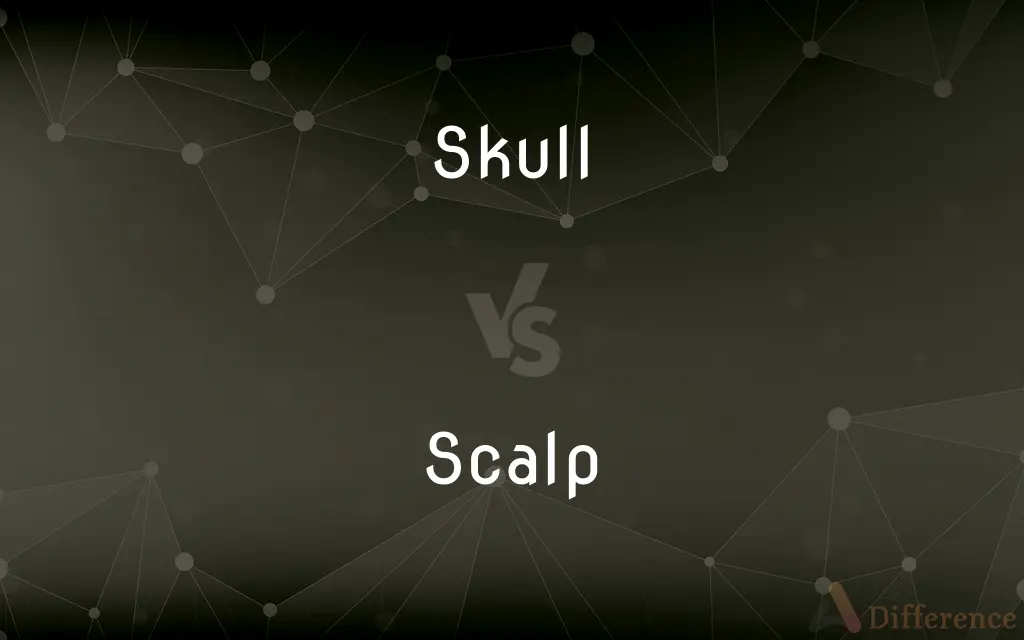Skull vs. Scalp — What's the Difference?
Edited by Tayyaba Rehman — By Fiza Rafique — Updated on February 29, 2024
The skull is a bony structure forming the head in vertebrates, housing the brain and supporting facial structures, while the scalp is the skin and subcutaneous tissue covering the top of the head, containing hair follicles and blood vessels.

Difference Between Skull and Scalp
Table of Contents
ADVERTISEMENT
Key Differences
The skull is located at the upper part of the skeletal system, composed primarily of bone, and serves as a protective casing for the brain. The scalp, on the other hand, lies externally on the top of the skull, composed of layers of skin and tissue, including the epidermis, dermis, and subcutaneous layer.
The primary function of the skull is to protect the brain and provide attachment points for the muscles of the head and neck. The scalp protects the skull from injuries and sun exposure, helps regulate body temperature through sweat and hair, and facilitates the growth of hair for additional protection and insulation.
The skull consists of several bones, including the cranium and facial bones, which are fused together but remain separate in infants to allow for brain growth. The scalp is structurally simpler, consisting of five layers (skin, connective tissue, aponeurosis, loose connective tissue, and pericranium) that work together to ensure flexibility, and nerve innervation.
Injuries or conditions affecting the skull, such as fractures or cranial surgery, require specialized medical intervention due to the risk to the brain and underlying structures. Scalp conditions, such as lacerations, dermatitis, or hair loss, while potentially serious, often involve less complex treatments like sutures, medication, or topical therapies.
Comparison Chart
Composition
Bone.
Skin, connective tissue, and vessels.
ADVERTISEMENT
Function
Protects the brain, supports facial structures.
Protects the skull, regulates temperature, supports hair growth.
Location
Forms the head's bony structure.
Covers the top of the skull.
Structural Complexity
Consists of several fused bones.
Consists of five layers including skin and subcutaneous tissue.
Medical Considerations
Involves specialized care for injuries, requires careful surgical intervention.
Conditions often treated with less complex medical or surgical approaches.
Compare with Definitions
Skull
Fused bones in both genders, but not in infants.
The soft spots on a baby's skull allow for brain growth.
Scalp
The skin covering the top of the skull, containing hair follicles.
The dermatologist treated the scalp condition with medication.
Skull
Comprises the cranium and facial bones.
Skull anatomy is crucial in forensic science for identifying remains.
Scalp
Helps regulate body temperature through sweat.
The scalp's sweat glands activate in hot weather.
Skull
Subject to specific pathologies like fractures.
Wearing helmets can prevent skull injuries in sports.
Scalp
Can be affected by conditions like dermatitis or alopecia.
Stress can sometimes lead to scalp issues, including hair loss.
Skull
Studied in anthropology to understand human evolution.
Ancient skulls provide insights into early human diets.
Scalp
The skin covering the top of the human head.
Skull
The bony structure that forms the head, protecting the brain.
The radiologist examined the X-ray for any skull fractures.
Scalp
Has five layers, including the epidermis and dermis.
Scalp lacerations can be more complex due to these layers.
Skull
The skull is a bone structure that forms the head in vertebrates. It supports the structures of the face and provides a protective cavity for the brain.
Scalp
The focus of cosmetic procedures for hair restoration.
Scalp micropigmentation is a method for addressing baldness.
Skull
A bone framework enclosing the brain of a vertebrate; the skeleton of a person's or animal's head
He broke his collar bone and fractured his skull
Scalp
The scalp is the anatomical area bordered by the human face at the front, and by the neck at the sides and back.
Skull
The bony or cartilaginous framework that encloses and protects the brain and sense organs of all vertebrates and of one group of nonvertebrates (the hagfishes); cranium.
Scalp
A portion of this skin with its attached hair, cut from a body especially as a battle trophy or as proof in claiming a bounty.
Skull
(Informal)The head, regarded as the seat of thought or intelligence
Use your skull and solve the problem.
Scalp
A piece of hide from the skull of certain animals, such as the fox, shown as proof of killing in order to collect a bounty.
Skull
The skeleton of the head of a vertebrate animal, including the brain case, or cranium, and the bones and cartilages of the face and mouth. See Illusts. of Carnivora, of Facial angles under Facial, and of Skeleton, in Appendix.
Scalp
The skin that covers the top of the head;
They wanted to take his scalp as a trophy
Skull
The head or brain; the seat of intelligence; mind.
Skulls that can not teach, and will not learn.
Scalp
Remove the scalp of;
The enemies were scalped
Skull
A covering for the head; a skullcap.
Let me put on my skull first.
Skull
The bony skeleton of the head of vertebrates
Common Curiosities
What common conditions affect the scalp?
Common scalp conditions include dandruff, dermatitis, psoriasis, and alopecia, each with various causes and treatments.
What is the main difference between the skull and scalp?
The skull is a bony structure that protects the brain, while the scalp is the layered skin covering the skull, supporting hair growth and aiding in temperature regulation.
Why is the skull composed of several bones, rather than being a single bone?
Multiple bones allow for flexibility and expansion during childbirth and infant brain growth, eventually fusing to provide robust protection.
Can the scalp affect the health of the skull?
Generally, scalp conditions do not directly affect the skull's health, but severe infections can potentially spread to deeper tissues.
How does the scalp contribute to body temperature regulation?
The scalp regulates temperature through the dilation and constriction of vessels and sweat production, helping to cool the body.
Can the skull and scalp be affected by genetic conditions?
Yes, both can be affected by genetic conditions; for example, craniosynostosis affects the skull, and certain types of alopecia affect the scalp.
How do doctors treat skull fractures?
Skull fractures often require careful monitoring, possible surgical intervention to repair the bone, and measures to protect the brain from injury.
What role does the skull play in forensic science?
In forensic science, the skull can provide vital clues about a person's identity, cause of death, and historical context.
How can one maintain a healthy scalp?
Maintaining a healthy scalp involves regular washing to remove oil and dead skin cells, using appropriate hair care products, and avoiding harsh chemicals.
Are there any surgical procedures for the scalp?
Yes, surgical procedures for the scalp include hair transplant surgery, scalp reduction, and treatment of scalp lacerations or lesions.
Share Your Discovery

Previous Comparison
Funny vs. Silly
Next Comparison
Bruin vs. GrizzlyAuthor Spotlight
Written by
Fiza RafiqueFiza Rafique is a skilled content writer at AskDifference.com, where she meticulously refines and enhances written pieces. Drawing from her vast editorial expertise, Fiza ensures clarity, accuracy, and precision in every article. Passionate about language, she continually seeks to elevate the quality of content for readers worldwide.
Edited by
Tayyaba RehmanTayyaba Rehman is a distinguished writer, currently serving as a primary contributor to askdifference.com. As a researcher in semantics and etymology, Tayyaba's passion for the complexity of languages and their distinctions has found a perfect home on the platform. Tayyaba delves into the intricacies of language, distinguishing between commonly confused words and phrases, thereby providing clarity for readers worldwide.














































